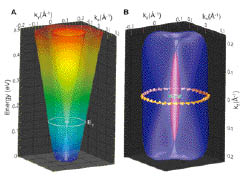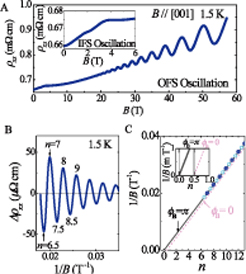Detection of Berry’s Phase in a Bulk Rashba Semiconductor
H. Murakawa, M. Tokunaga, and Y. Tokura
The geometrical information of the system parameter can be encoded in the wave function as a Berry’s phase and governs the system properties. In quantum systems, Berry’s phase can be a source for various emergent phenomena. Despite its ubiquity, there are few experimental observations of Berry’s phase of bulk states. Here, we report detection of a nontrivial π Berry’s phase in the bulk Rashba semiconductor BiTeI via analysis of the Shubnikov-de Haas (SdH) effect.

Fig. 1. (A) Energy band dispersion of the Rashba spin split band in BiTeI. (B) The inner and outer Fermi surfaces and helical spin textures (arrows) in BiTeI.

Fig. 2. (A) Magnetoresistivity of BiTeI sample. (B) The oscillatory component as a function of 1/B. (C) Landau index plot of the outer Fermi. (inset) Magnified view around the intercept.
BiTeI has a polar crystal structure made up of stacked layers of bismuth (Bi), tellurium (Te) and iodine (I) atoms. Because of the absence of inversion symmetry and the strong polarity of the system, accompanied by the strong spin-orbit interaction of Bi, an extremely large Rashba spin splitting occurs in a bulk scale (Fig. 1A). As shown in Fig. 1B, two coaxial spin polarized Fermi surfaces verging at Dirac point, namely, inner and outer Fermi surfaces (IFS and OFS, respectively) are formed. Theoretical prediction indicates that electrons on both FSs with the circular spin texture acquire π Berry’s phase (øB = π) and varies the system energy from the trivial case (øB = 0). Under magnetic field, Landau levels in a Dirac system with øB = π locate at the middle of those in a system with øB = 0. Thus, π Berry’s phase can be detected as a π phase shift in quantum oscillation.
The extremely large Rashba spin splitting in BiTeI has great advantages on observing the Berry’s phase. The large ratio of the extremal cross-sectional areas (AN) of IFS and OFS enables the clear separation of the two sets of SdH oscillations. Moreover, the giant Rashba energy can dominate the Zeeman effect and preserve the circular spin texture even in a high magnetic field region. According to the Lifshitz-Onsager quantization rule, ANℏ/eB = 2π(n + 1/2 - øB/2π) = 2π(n + γ) , Berry’s phase is obtained as an intercept value γ in the linear relation between 1/B and Landau index number n. For precise evaluation, observation of the SdH oscillation down to lower Landau level is important. Therefore, high-magnetic field measurement with use of the non-destructive pulse magnet can be a powerful tool. Figure 2A shows the SdH oscillation from the OFS up to 56 T. We assign integer indices to the ρxx peak positions in 1/B and half integer indices to the ρxx valley positions (Fig. 2B). As shown in Fig. 2C, the interpolation line has almost zero intercept (γ = 1/2 – øB/2π = 0), confirming the existence of π Berry’s phase in the 3-dimensional Rashba semiconductor BiTeI.
References
- [1] H. Murakawa, M. S. Bahramy, M. Tokunaga, Y. Kohama, C. Bell, Y. Kaneko, N. Nagaosa, H. Y. Hwang, and Y. Tokura, Science 342, 1490 (2013).
